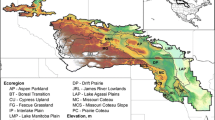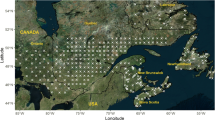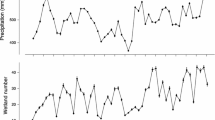Abstract
The Prairie Pothole Region (PPR) of the Northern Great Plains is the most important breeding area for waterfowl in North America. Historically, the size of breeding duck populations in the PPR has been highly correlated with spring wetland conditions. We show that one indicator of climate conditions, the Palmer Drought Severity Index (PDSI), is strongly correlated with annual counts (from 1955 to 1996) of both May ponds (R2 = 0.72, p < 0.0001) and breeding duck populations (R2 = 0.69, p < 0.0001) in the Northcentral U.S., suggesting the utility of PDSI as an index for climatic factors important to wetlands and ducks. We then use this relationship to project future pond and duck numbers based on PDSI values generated from sensitivity analyses and two general circulation model (GCM) scenarios. We investigate the sensitivity of PDSI to fixed changes in temperature of 0°C, +1.5°C, +2.5°C, and +4.0°C in combination with fixed changes in precipitation of -10%, +0%, +7%, and +15%, changes spanning the range of typically-projected values for this region from human-induced climatic change. Most (11 of 12) increased temperature scenarios tested result in increased drought (due to greater evapotranspiration under warmer temperatures) and declining numbers of both wetlands and ducks. Assuming a doubling of CO2 by 2060, both the equilibrium and transient GCM scenarios we use suggest a major increase in drought conditions. Under these scenarios, Northcentral U.S. breeding duck populations would fluctuate around means of 2.1 or 2.7 million ducks based on the two GCMs, respectively, instead of the present long-term mean of 5.0 million. May pond numbers would fluctuate around means of 0.6 or 0.8 million ponds instead of the present mean of 1.3 million. The results suggest that the ecologically and economically important PPR could be significantly damaged by climate changes typically projected. We make several recommendations for policy and research to help mitigate potential effects.
Similar content being viewed by others
References
Baldassarre, G. A. and Bolen, E. G.: 1994, Waterfowl Ecology and Management. John Wiley and Sons, Inc., New York.
Ball, I. J., Gilmer, D. S., Cowardin, L. M. and Riechmann, J. H.: 1975, ‘Survival of Wood Duck and Mallard Broods in North-Central Minnesota’, J. Wildl. Manage. 39, 776–780.
Batt, B. D. J., Anderson, M. G., Anderson, C. D. and Caswell, F. D.: 1989, ‘The Use of Prairie Potholes by North American Ducks’, in van der Valk, A.G. (ed.), Northern Prairie Wetlands, Iowa State University Press, Ames, pp. 204–227.
Beebee, T. J. C.: 1995, ‘Amphibian Breeding and Climate’, Nature 374, 219–220.
Bellrose, F. C.: 1980, Ducks, Geese, and Swans of North America, Stackpole Books, Harrisburg, PA.
Caithamer, D. F. and Dubovsky, J. A.: 1996, ‘Waterfowl Population Status, 1996’, U.S. Fish and Wildlife Service, Office of Migratory Bird Management, Branch of Surveys and Assessment, 28 pp.
Calverley, B. K. and Boag, D. A.: 1977, ‘Reproductive Potential in Parkland and Arctic-Nesting Populations of Mallards and Pintails (Anatidae)’, Can. J. Zool. 55, 1242–1251.
Cowardin, L. M., Gilmer, D. S. and Shaiffer, C. W.: 1985, ‘Mallard Recruitment in the Agricultural Environment of North Dakota’, Wildl. Monogr. 92, 1–37.
Crick, H. Q. P., Dudley, C., Glue, D. E., and Thomson, D. L.: 1997, ‘UK Birds Are Laying Eggs Earlier’, Nature 388, 526.
Crissey, W. F.: 1969, ‘Prairie Potholes from a Continental Viewpoint’, in Saskatoon Wetlands Seminar, Can. Wildl. Serv. Rep. Ser. 6, pp. 161–171.
Davies, J. C. and Cooke, F.: 1983, ‘Annual Nesting Productivity in Snow Geese: Prairie Droughts and Arctic Springs’, J. Wildl. Manage. 47, 291–296.
Derksen, D. V. and Eldridge, W. D.: 1980, ‘Drought-displacement of Pintails to the Arctic Coastal Plain, Alaska’, J. Wildl. Manage. 44, 224–229.
Duebbert, H. F. and Frank, A. M.: 1984, ‘Value of Prairie Wetlands to Duck Broods’, Wildl. Soc. Bull. 12, 27–34.
Dzubin, A. and Gollop, J. B.: 1972, ‘Aspects of Mallard Breeding Ecology in Canadian Parkland and Grassland’, U.S. Fish and Wildl. Serv. Wildl. Res. Rep. 2, 113–152.
Friend, M.: 1981, ‘Waterfowl Management and Disease: Independent of Cause and Effect Relationships?’, Trans. North Am. Wildl. Nat. Resour. Conf. 46, 94–103.
Gleick, P. H.: 1987, ‘Regional Hydrologic Consequences of Increases in Atmospheric CO2 and other Trace Gases’, Clim. Change 10, 137–161.
Gorham, E.: 1994, ‘The Future of Research in Canadian Peatlands: a Brief Survey with Particular Reference to Global Change’, Wetlands 14, 206–215.
Greenwood, R. J., Sargeant, A. B., Johnson, D. H., Cowardin, L. M. and Shaffer, T. L.: 1995, ‘Factors Associated with Duck Nest Success in the Prairie Pothole Region of Canada’, Wildl. Monogr. 128, 1–57.
Grotch, S. L. and MacCracken, M. C.: 1991 ‘The Use of General Circulation Models to Predict Regional Climatic Change’, J. of Climate 4, 286–303.
Hansen, H. A. and McKnight, D. E.: 1964, ‘Emigration of Drought-displaced Ducks to the Arctic’, Trans. North Am. Wildl. Nat. Resourc. Conf. 29, 119–126.
Hansen, J. I., Rind, D., Delgenio, A., Lacis, A., Lebedeff, S., Prather, M., Ruedy, R., and Karl, T.: 1989, ‘Regional Greenhouse Climate Effects’, in Proc. 2nd Amer. Conf. on Preparing for Climate Change, Climate Inst., Washington, D.C., pp. 211–229.
Henny, C. J., Anderson, D. R. and Pospahala, R. D.: 1972, ‘Aerial Surveys of Waterfowl Production in North America, 1955–1971’, U.S. Fish and Wildl. Serv. Spec. Sci. Rep. Wildl. 160.
Hinkle, M. K.: 1996, Oases for Wildlife, Small and Farmed Wetlands. National Audubon Society, Washington, D.C.
Intergovernmental Panel on Climate Change.: 1990, ‘Climate Change: The IPCC Scientific Assessment’, Houghton, J. T., Jenkins, G. J., and Ephraums, J. J. (eds). Cambridge University Press, Cambridge.
Intergovernmental Panel on Climate Change.: 1996a. ‘Climate Change 1995 The Science of Climate Change’, Houghton, J. T., Meira Filho, L. G., Callander, B. A., Harris, N., Kattenberg, A., and Maskell, K. (eds), Cambridge University Press, Cambridge.
Intergovernmental Panel on Climate Change.: 1996b, ‘Climate Change 1995 Impacts, Adaptations and Mitigation of Climate Change: Scientific-Technical Analyses’, Watson, R. T., Zinyowera, M. C., Moss, R. H. (eds). Cambridge University Press, Cambridge.
Johnson, D. H. and Grier, J. W.: 1988, ‘Determinants of Breeding Distributions of Ducks’, Wildl. Monogr. 100, 1–37.
Johnson, D. H., Nichols, J. D. and Schartz, M. D.: 1992, ‘Population Dynamics of Breeding Waterfowl’ in Batt, B. D. J. et al. (eds), Ecology and Management of Breeding Waterfowl, University of Minnesota Press, Minneapolis, pp. 446–485.
Johnston, K. M. and Schmitz, M. D.: 1997, ‘Wildlife and Climate Change: Assessing the Sensitivity of Selected Species to Simulated Doubling of Atmospheric CO2’, Glob. Change Biol. 3, 531–544.
Kaminski, R. M. and Weller, M. W.: 1992, ‘Breeding Habitats of Nearctic Waterfowl’ in Batt, B. D. J. et al. (eds), Ecology and Management of Breeding Waterfowl, University of Minnesota Press, Minneapolis, pp. 568–589.
Karl, T. R., Nicholls, N. and Gregory, J.: 1997, ‘The Coming Climate’, Sci. Am. 276, 78–83.
Krapu, G. L. and Duebbert, H. F.: 1989, ‘Prairie Wetlands: Characteristics, Importance to Waterfowl, and Status’ in Sharitz, R. R. and Gibbons, J. W. (eds), Freshwater Wetlands and Wildlife, DOE Symposium Series No. 61, OSDOE Office of Scientific and Technical Information, Oak Ridge, TN, pp. 811–828.
Krapu, G. L., Klett, A. T. and Jorde, D. G.: 1983, ‘The Effect of Variable Spring Water Conditions on Mallard Reproduction’, Auk 100, 689–698.
Lamb, P. J.: 1987, ‘On the Development of Regional Climatic Scenarios for Policy-oriented Climate Impact Assessment’, Bull. Am. Meteorol. Soc., 68, 1116–1123.
La Roe, T.: 1991, The Effects of Global Climate Change on Fish and Wildlife Resources’, Trans. North Am. Wildl. Nat. Resour. Conf. 56, 171–176.
Larson, D. L.: 1995, ‘Effects of Climate on Numbers of Northern Prairie Wetlands’, Clim. Change 30, 169–180.
Manabe, S. and Wetherald, R. T.: 1987, ‘Large-scale Changes of Soil Wetness Induced by an Increase in Atmospheric Carbon Dioxide’, J. Atmos. Science 44, 1211–1236.
McCabe, Jr. G. J., Wolock, D. M., Hay, L. E. and Ayers, M. A.: 1990, ‘Effects of Climatic Change on the Thornthwaite Moisture Index’, Water Res. Bull. 26, 633–643.
McKirney, F., Derrickson, S. R. and Mineau, P.: 1983, ‘Forced Copulation in Waterfowl’, Behaviour 86, 250–294.
Mearns, L. O., Katz, R. W. and Schneider, S. H.: 1984, ‘Extreme High-temperature Events: Changes in their Probabilities with Changes in Mean Temperature’, J. Climate Appl. Meteor. 23, 1601–1613.
Mimikou, M., Kouvopoulos, Y., Cavadias, G. and Vayianos, N.: 1991, ‘Regional Hydrological Effects of Climate Change’, J. Hydrology 123, 119–146.
Murkin, H. R., Murkin, E. J. and Ball, J. P.: 1997, ‘Avian Habitat Selection and Prairie Wetland Dynamics: a 10-Year Experiment’, Ecol. Applic. 7, 1144–1159.
Murphy, J. M. and Mitchell, J. F. B.: 1995, ‘Transient Response of the Hadley Centre Coupled Ocean-atmosphere to Increasing Carbon Dioxide’, J. Climate 8, 36–80.
Neter, J., Wasserman, W. and Kutner, M. H.: 1990, Applied Linear Statistical Models, 3rd ed. Irwin, Barr Ridge, IL.
Palmer, W. C.: 1965, ‘Meteorological Drought’, U.S. Dep. of Commerce Res. Pap. 45, 1–58.
Patterson, J. H.: 1995, ‘The North American Waterfowl Management Plan and Wetlands for the Americas Programmes: a Summary’, Ibis 137, S215–S218.
Poiani, K. A. and Johnson, C. W.: 1991, ‘Global Warming and Prairie Wetlands’, BioScience 41, 611–618.
Poiani, K. A. and Johnson, C. W.: 1993, ‘Potential Effects of Climate Change on a Semipermanent Prairie Wetland’, Clim. Change 24, 213–232.
Poiani, K. A., Johnson, C. W. and Kittel, T. G. F.: 1995, ‘Sensitivity of Prairie Wetland to Increased Temperature and Seasonal Precipitation Changes’, Water Res. Bull. 31, 283–294.
Pospahala, R. S., Anderson, D. R. and Henny, C. J., 1974, ‘Population Ecology of the Mallard II. Breeding Habitat Conditions, Size of the Breeding Populations, and Population Indices’, U.S. Fish and Wildl. Serv. Res. Publ. 115. 73 pp.
Riebsame, W. E.: 1990, ‘Anthropogenic Climate Change and a New Paradigm of Natural Resource Planning’, Prof. Geogr. 42, 1–12.
Rind, D., Goldberg, R., Hansen, J., Rosenzweig, C. and Ruedy, R.: 1990, ‘Potential Evapotranspiration and the Likelihood of Future Drought’, J. Geophys. Res. 95, 9983–10,004.
Rogers, J. P.: 1964, ‘Effect of Drought on Reproduction of Lesser Scaup’, J. Wildl. Manage. 28, 213–222.
Root, T.: 1997, ‘How to Approach Assessing Climate Impacts on Animals’, in Hassol, S. J. and Katzenberger, J. (eds), Elements of Change 1996, Aspen Global Change Institute, Aspen, CO, pp. 203–206.
Rosenberg, N. J.: 1992, ‘Adaptation of Agriculture to Climate Change’, Clim. Change 21, 385–405.
Rosenzweig, C.: 1985, ‘Potential CO2-induced Climate Effects on North American Wheat Producing Regions’, Clim. Change 7, 367–389.
Rosenzweig, C. and Hillel, D.: 1993, ‘Plant and Environment Interactions’, J. Environ. Qual. 22, 9–22.
Rotella, J. J. and Ratti, J. T.: 1992a, ‘Mallard Brood Survival and Wetland Habitat Conditions in Southwestern Manitoba’, J. Wildl. Manage. 56, 499–507.
Rotella, J. J. and Ratti, J. T.: 1992b, ‘Mallard Brood Movements and Wetland Selection in Southwestern Manitoba’, J. Wildl. Manage. 56, 508–515.
Schneider, S. H.: 1989, ‘The Greenhouse Effect: Science and Policy’, Science 243, 771–781.
Schneider, S. H., Mearns, L., and Gleick, P. H.: 1992, ‘Climate-Change Scenarios for Impact Assessment’ in Peters, R. L. and Lovejoy, T. E. (eds), Global warming and Biological Diversity, Yale University Press, New Haven, pp. 38–52.
Shaw, S. P. and Fredine, C. G.: 1956, ‘Wetlands of the United States’, U.S. Fish and Wildl. Serv. Circ. 39, 67 pp.
Smith, G. W.: 1995, ‘A Critical Review of the Aerial and Ground Surveys of Breeding Waterfowl in North America’, Biol. Sci. Rept. 5.
Swanson, G. A.: 1988, ‘Aquatic Habitats of Breeding Waterfowl’, in Hook, D. D. (ed). Ecology and Management of Wetlands. vol. 1. Ecology of Wetlands, Timber Press, Portland, OR, pp. 195–202.
Talent, L. G., Jarvis, R. L. and Krapu, G. L.: 1983, ‘Survival of Mallard Broods in South-Central North Dakota’, Condor 85, 74–78.
Thornthwaite, C. W.: 1948, ‘An Approach Toward a Rational Classification of Climate’, Geogr. Rev. 38, 55–94.
U.S. Department of the Interior, Fish and Wildlife Service and U.S. Department of Commerce, Bureau of the Census: 1997, ‘1996 National Survey of Fishing, Hunting, and Wildlife-Associated Recreation’, Washington, D.C.
Wetherald, R. T. and Manabe, S.: 1995, ‘The Mechanisms of Summer Dryness Induced by Greenhouse Warming’, J. Climate 8, 3096–3108.
Winter, T. C.: 1989, ‘Hydrologic Studies of Wetlands in the Northern Prairie’ in van der Valk, A.G. (ed.), Northern Prairie Wetlands, Iowa State University Press, Ames, pp. 16–54.
Author information
Authors and Affiliations
Rights and permissions
About this article
Cite this article
Sorenson, L.G., Goldberg, R., Root, T.L. et al. Potential Effects of Global Warming on Waterfowl Populations Breeding in the Northern Great Plains. Climatic Change 40, 343–369 (1998). https://doi.org/10.1023/A:1005441608819
Issue Date:
DOI: https://doi.org/10.1023/A:1005441608819




